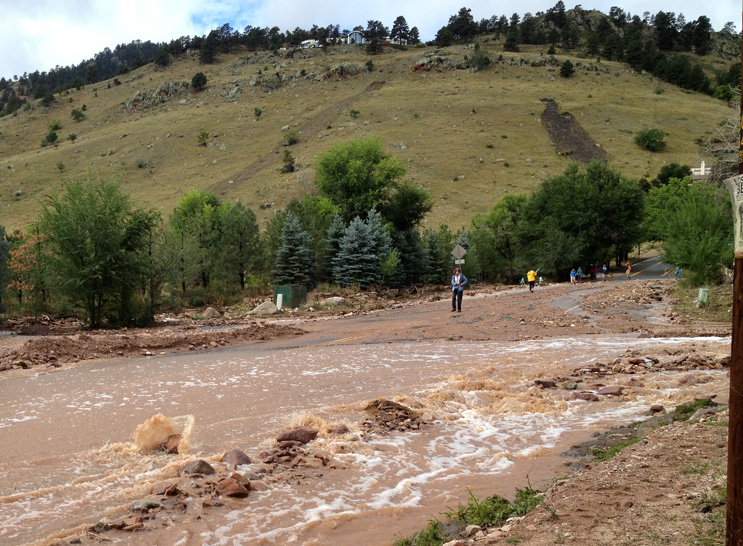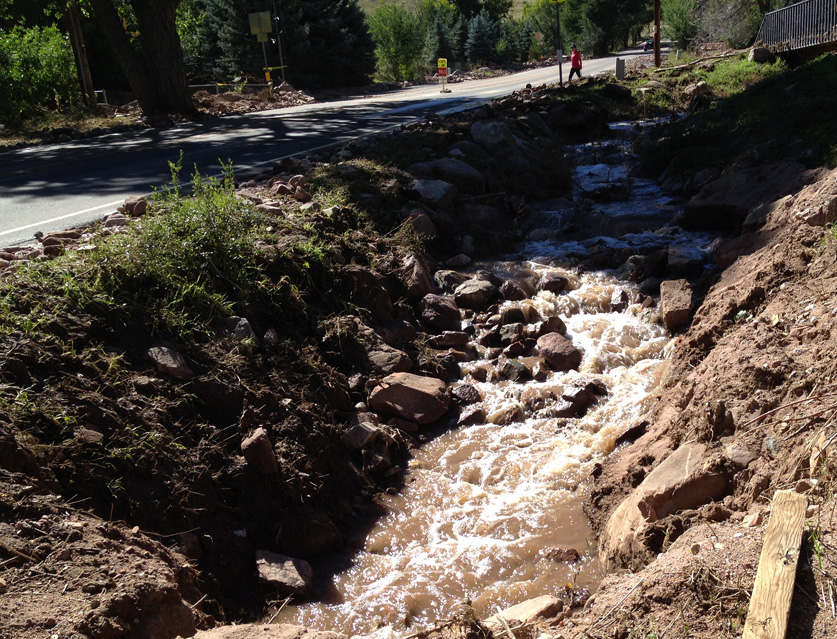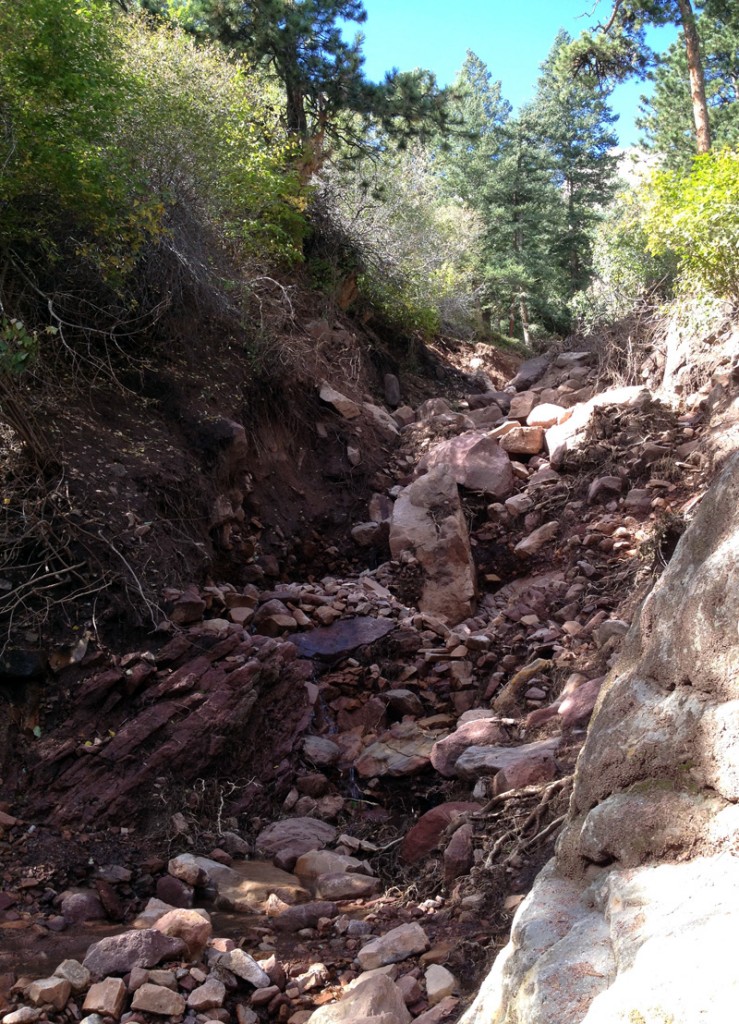Our move to New Mexico in December may have taken place with lightning speed, but as I look back over the fall I see months of internal preparation that I hardly realized at the time were happening. And a lot of that preparing was shaped by the Boulder flood.
Way back in September, while the rains that made the flood were still falling, my longtime friend Malidoma Somé came to Boulder on a speaking tour. It was the first time we’d seen each other in the more than fifteen years since we’d worked together in Oakland on his book The Healing Wisdom of Africa. That night in flooded Boulder he encouraged each person in the room to listen for what the water was saying to them. “There is tremendous life-force in the flood,” he said. “What is that water wanting to share with you to help you release your gifts into the world?”
I’d been thinking along similar lines, discontent with the judgment so many people fall into during so-called disasters. If an unexpected event is a challenging one, it must be some form of punishment. “There is some confusion in people’s minds between a spiritual perspective and a judging perspective,” a wise friend told me during that time. Malidoma and my friend were suggesting something similar: find the interpretation of an event that supports you in opening to the future. Find the story that empowers.
So in the weeks following the flood, as my community picked itself up and helped one another clean up, I listened closely for what water was saying. And here are a few of the empowering things I heard.
1. Keep the water-paths open.
The empowering story for me began to center on the free flow of water: how waters must be free to do their cleansing work across the land.
In Boulder I lived near a creek that everyone had forgotten, Twomile Canyon Creek. Culverted for a century and then dammed in 2005 a mile above town, Twomile Canyon Creek as it ran through my neighborhood was only a dry bed—until days of rain caused it to swell and spill. It shrugged at culverts and streamed in its old path downhill, flooding houses west of Broadway near Iris, Juniper, and Kalmia. The water poured for days across Spring Valley and Linden Drives.
I was fascinated by Twomile Canyon Creek’s fresh vigor. So was everyone else in the area. With Bodhi, I would walk to Linden and encounter others also making their pilgrimage to stand and watch and listen to the surging flow, all of us trying to wrap our heads around such tremendous power.
Keeping water-paths open can apply to sewer lines and creekbeds; it can also apply to the chambers of the human heart. Let the inner streams be open and free, the water seemed to suggest. Don’t get in the way of inspiration. Be available for the fresh influx of powerful flows you may have forgotten—or never recognized.
Images of water flowing over roads stayed with me for weeks, even after the creek had subsided again to a friendly gurgle.
The memory of the flowing water began to beat a mantra all its own:
2. Let old structures fall.
Old, inhibiting structures will crack under the onslaught of a flood. Let them, the water said. Whatever impedes the flow of life-force needs to be called into question. Old structures can mean dams and roads and houses standing in the way of a creek. It can also mean the structures of life that we rely on to usher us from one day into the next: a well-worn identity in work or love, our super qualifications for jobs that may no longer be compelling. When the old structures crack, the water said, don’t try to shore them up. Let them fall.
3. Things can change overnight.
We all know that things change suddenly. We also fear it. And because of our fear we don’t allow ourselves to dwell in the awareness of change. Only when life suddenly shifts do we realize just how much we were counting on it to stay the same.
The power of water to reshape the land we thought we knew was nowhere so obvious as in Chautauqua Park, where water flowing off the Flatirons punched brand-new canyons into the earth. In moments, forty-foot-deep canyons suddenly opened, their many tons of displaced boulders racing downstream with what neighbors said was the roar of a freight train. It was a miracle that no one in the streets below the park was killed or seriously injured.
The park as we knew it was transformed. We were used to the trails looking one way, and we loved them that way. We had forgotten that the ground beneath our feet, which may look stable, is in fact a churning mass of change. Every creekbed has been scoured by water. Every canyon winding out of hills was first eroded out of flat earth, then widened and deepened over and over again, perhaps several times a century, by raging floodwaters. We think of changes in rock and soil taking place on the scale of geologic time. We forget that the drama can unfold in a single night.
Boulder’s Open Space and Mountain Parks offered flood hikes for the public every weekend during the fall to see lands changed by the waters. I went many times to visit those brand-new canyons. To try to comprehend the immensity of water’s power. To see if absorbing changes in the land could help make peace with changes in life. Each time I visited those new canyons, I was astonished all over again.
I regret that I won’t be in Boulder to continue being astonished—to watch the land adjust, week by week, to its new shape. Spring and summer will bring many opportunities for wonder. Yet I sense that even the few weeks I enjoyed during the fall worked some magic. Living through the abrupt changes of the flood prepared me for rapid changes in life. Feeling devastation and awe set the stage for sudden and sweeping changes in other parts of life.
When the opportunity arose for us to move to Santa Fe, we found that something in us had been cleaned away. With barely a pause, we said yes.
I can’t resist closing with a couplet from Rumi that I used in the book:
The speech of water, the speech of earth, and the speech of mud
Are heard by those who listen with the heart.
—Rumi, The Mathnawi
May the stories you listen to always be stories that empower.



Thank you, Priscilla, for helping me view the flood and so many other changes around me from a higher, healing, and natural perspective.
Thanks for dropping by, Rivvy! It really bothers me when people take a judging view of natural events, from illness to floods and other weather events. It’s not about what we did wrong; it’s about how to mend and learn, and especially what strengths to gain from it. But, Rivvy, you wrote a book about finding the sacred in everyday life! Readers, check out her RECIPES FOR A SACRED LIFE for beautiful tales and simple miracles.
Thanks so much for this carefully and beautifully written piece about this important subject. We humans really have our hands full now what with all the unfortunate over-regulation of the natural world. Now that the flood waters have spoken there is an opportunity to listen and do things differently, like you say. I hope our community listens carefully on a governmental as well as individual level. You are showing the way.
I hope too that local government chooses to listen to water. Boulder led the way decades ago with how it treated Boulder Creek. But now there’s a lot more work to be done with other creeks and drainages coming out of the mountains–lots of in-town creek restoration projects waiting to happen. I was looking forward to being a part of those restoration efforts–until I got called elsewhere! Now I’m looking forward to getting to know the rivers and bosques here in Santa Fe.
In the last four months since the flood, I’ve experienced so many levels of transformation I scarcely know where to begin. Like you, I’ve been out on the trails, gasping at the power of the water to alter the contours of the land. Our home’s flooded downstairs has been transformed, and us with it, toward colorful simplicity–silver for the clouds’ linings, blue for the water, black for the mystery.
Another book in the making, Gail? Readers, check out her I PROMISE NOT TO SUFFER for a beautiful story of transformation through hiking the Pacific Crest Trail. Your downstairs sounds beautiful–and apt! There are many flood stories waiting to be told, no?
Lovely piece Priscilla! The one thing we can always count on is change…and though it can be hard to adjust; it’s what causes growth–both professional and emotional!
I’ve loved seeing how the community has responded to the flood with an outpouring of support. It makes me think that this was a good place to move.
I hope you’re settling in there in New Mexico!
Thank you, Jill! Yes, we’re having a good time settling in here in Santa Fe, as I trust you are in Boulder.